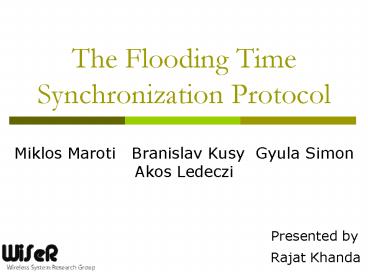The Flooding Time Synchronization Protocol - PowerPoint PPT Presentation
1 / 27
Title:
The Flooding Time Synchronization Protocol
Description:
What are the uncertainties in Radio Message Delivery? ... interrupt handling and encoding decoding times by recording multiple time stamps ... – PowerPoint PPT presentation
Number of Views:129
Avg rating:3.0/5.0
Title: The Flooding Time Synchronization Protocol
1
The Flooding Time Synchronization Protocol
- Miklos Maroti Branislav Kusy Gyula Simon Akos
Ledeczi -
Presented by -
Rajat Khanda
2
Contents
- Introduction
- Approaches to the Synchronization
- What are the uncertainties in Radio Message
Delivery? - How does Flooding Time Synchronization Protocol
Work? - Comparison to existing protocols
- Results
- Conclusion
3
Introduction
- Potential Applications of WSN
- 1. Monitoring Applications
- 2. Mobile Commerce
- 3. Smart Office
- 4. Military Applications
- Goal of FTSP
4
Approaches to the Synchronization
- Network Time Protocol
- Reference Broadcast Protocol
- Timing-Sync Protocol for Sensor Network
5
Uncertainties of Radio Message Delivery
- Send Time
- Access Time
- Transmission time
- Propagation time
- Reception time
- Receive time
6
Uncertainties of Radio Message Delivery
7
Uncertainties of Radio Message Delivery
- Interrupt Handling Time
- Encoding Time
- Decoding Time
- Byte Alignment Time
8
Uncertainties of Radio Message Delivery
9
Working Principle of FTSP
- Assumptions
- 1. Every node in the network has an
unique id - 2. Each node has a local clock and
can communicate to its neighbors over
an unreliable link - Goal
- To achieve a network wide
synchronization with high precision
10
Working Principle of FTSP
- Time Stamping
- Broadcast message contains the senders time
stamp (The estimated global time) - synchronization point (a global local time pair )
11
Working Principle of FTSP
- Reduces the jitter of interrupt handling and
encoding decoding times by recording multiple
time stamps - Receiver further corrects the average time stamp
using the byte alignment time - Accuracy depends on the number of time stamps
taken to find the average time
12
Working Principle of FTSP
- Clock Drift Management
- 1. Local clocks does not a have a exact same
frequency - 2. Offset between clocks changes in linear
fashion if the stability is good - 3. Clock skew is estimated using linear
regression on the received data points
13
Working Principle of FTSP
14
Working Principle of FTSP
15
Working Principle of FTSP
- Multi-hop Time Synchronization
- 1. Root node (a special node dynamically
re-elected by the network, to which the whole
network is synchronized) - 2. A synchronized node can broadcast the
synchronization message - 3.Synchronization message contains-root-ID,
time stamp, and Sequence number - 4.Redundant information management
16
Working Principle of FTSP
- Root-ID ID of the root as known by the
sender of the message - Time stamp Global time estimate of the
transmitter - SeqNumber the sequence number set and
incremented by the root when - when a new synchronization round
is started
17
Working Principle of FTSP
18
Working Principle of FTSP
19
Working Principle of FTSP
- Convergence Properties
- 1. Depends on the speed of information
propagation in the network - When
- NUMENTRIES_LIMITN
- ROOT_TIMEOUTM
- Broadcast Message is P and Radius of Network
is R - The total time to get synchronized is between
- P(M(N-1)R) and P(MNR)
20
Working Principle of FTSP
- A Synchronization Period
- When a root fails and the New network Radius is
R , total time of reelection processltPRPMPR
21
Experimental Setup
22
Result
23
Comparison to Existing Protocols
- RBS improves accuracy by removing send and access
delay. - Average error for single hop is 29.1
micro-second - TPSN improves over RBS by removing byte alignment
and propagation delay - Average error for single hop 16.9 micro-second
- The draw back of this protocol is difficulties
in implementing in different platform
24
Comparison to Existing Protocols
- FTSP uses a fine-grained clock, MAC layer time
stamping with several jitter reducing techniques
to achieve high precision. - Average error for single hop is 1.48
mico-second - If the resynchronization period is T
- FTSP sends 1 message per T seconds
- TPSN sends 2 message per T seconds
- RBS sends 1.5 message per T seconds
25
Conclusion
- It performs better than the other existing time
sync protocol in terms of precision - Uses single broadcast message to establish
synchronization point - This is robust to topology changes and root or
link failure
26
Questions?
27
Thank you































